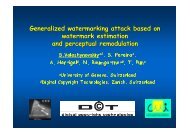SPREAD SPECTRUM WATERMARKING FOR REAL IMAGES: IS IT ...
SPREAD SPECTRUM WATERMARKING FOR REAL IMAGES: IS IT ...
SPREAD SPECTRUM WATERMARKING FOR REAL IMAGES: IS IT ...
You also want an ePaper? Increase the reach of your titles
YUMPU automatically turns print PDFs into web optimized ePapers that Google loves.
Encoder<br />
x<br />
n<br />
w w b<br />
Decoder<br />
Channel<br />
Figure 1: Communications with side information available at<br />
the encoder.<br />
w w w<br />
16000<br />
14000<br />
12000<br />
10000<br />
8000<br />
6000<br />
4000<br />
2000<br />
0<br />
<br />
Figure 3: Power spectrum of AR(1) process; σ 2 X =410,<br />
ρ=0.95.<br />
Figure 2: Equivalent communication channels when side information<br />
is available (a) and unavailable (b) at the encoder.<br />
available at the encoder and it is possible to approach capacity<br />
of the ideal AWGN channel (Fig. 2,a) based on Costa’s<br />
scheme:<br />
C = 1 2 log 2 (1+WNR), (1)<br />
( σ 2<br />
)<br />
where Watermark-to-Noise Ratio WNR = 10log W 10 . In<br />
σN<br />
2<br />
case of the open switch, side information is not presented at<br />
the encoder and system performance is sacrificed from host<br />
interference (Fig. 2,b). The corresponding capacity formula<br />
is determined as:<br />
C = 1 2 log 2<br />
(<br />
1+ σ W<br />
2 )<br />
σN 2 + σ X<br />
2 . (2)<br />
It is evident that direct application of (1) and (2) to<br />
real images demonstrates obvious performance advantages<br />
of known-host-state methods under AWGN attack.<br />
Data hiding for real images : Digital watermarking<br />
in still images is based on the specific properties of this type<br />
of media. As it was mentioned in the introductory part of<br />
the paper, the stochastic image model plays the crucial role.<br />
Several models have been proposed in the literature for real<br />
images both in the coordinate and in the transform domain<br />
[7, 8, 15]. To capture local correlation of natural images we<br />
use 1-D autoregressive process of the first order. The advantage<br />
of this model is its simplicity and tractability both in the<br />
coordinate and in the transform domain. Additionally, it provides<br />
a good fit to the power spectral density of real images.<br />
In this case the power spectral density of the host signal<br />
is determined by [7]:<br />
S XX (ω) = σX<br />
2 1 − ρ 2<br />
1+ρ 2 − 2ρ cos(ω) , (3)<br />
where −1 ≤ ρ ≤ 1 is a correlation coefficient and −π ≤ ω ≤<br />
π. Power spectral density of AR(1) process is shown in Fig.<br />
3.<br />
It is clear (Fig. 3) that a white Gaussian watermark in (2)<br />
is not any more optimal because of non-effective allocation<br />
of watermark energy.<br />
Therefore, the problem of the optimal watermark power<br />
allocation for such correlated data and AWGN channel in the<br />
frequency domain could be formulated based on the waterpouring<br />
principle [3]: it is necessary to maximize the mutual<br />
information between channel input and output subject to the<br />
following power constraint:<br />
1 ∫<br />
2π<br />
max I(W;Ŵ) (4)<br />
Ω S WW(ω)dω=P emb<br />
and for S WW (ω)≥ 0. Using methods of Lagrange multipliers<br />
and taking into account that the noise power spectrum is<br />
constant, S NN (ω)=σN 2 , this maximization problem could be<br />
formulated in the following form:<br />
max SWW (ω)J(S WW (ω)) =<br />
= 1 ∫ (<br />
1<br />
2π Ω 2 log 2 1+ S )<br />
WW(ω)<br />
S XX (ω)+σN<br />
2 −<br />
( ∫ 1<br />
− λ S WW (ω)dω − P emb<br />
). (5)<br />
2π<br />
Ω<br />
The solution to this problem is given by:<br />
S opt<br />
WW (ω) = ⎧<br />
⎨<br />
⎩<br />
σ 2 (1 − ρ 2 )<br />
1+ρ 2 − 2ρcos(ω ′ )<br />
Θ − S XX (ω) − σ 2 N , if<br />
S XX (ω)+σ 2 N < Θ ,<br />
0, otherwise,<br />
where the constant Θ is selected to satisfy the power constraint<br />
in (4). Thus, the obtained result determines those<br />
frequency channels where watermark energy should be allocated:<br />
no energy will be distributed to low frequency components<br />
containing most of the host signal power. The internal<br />
boundaries of the frequency range [-π; −ω ′ ]∪[ω ′ ; π] of the<br />
watermark power spectrum (Fig. 4) can be obtained from the<br />
solution of the following equation:<br />
) (1 − ω′<br />
− σ 2 +<br />
π<br />
+ 2σ 2 ( ( 1+ρ ω<br />
′<br />
π arctg 1 − ρ tg 2<br />
(6)<br />
))<br />
= P emb . (7)<br />
We will refer to the embedding according to (6) and (7)<br />
as to optimized spread spectrum (OSS).<br />
Having solved eq. (7) with respect to ω ′ one obtains<br />
S opt<br />
WW (ω) = S XX(ω ′ ) − S XX (ω), (8)<br />
and the resulting capacity of OSS is:<br />
C = 1 ∫ π<br />
(<br />
1<br />
π ω ′ 2 log SXX (ω ′ )+σN<br />
2<br />
2<br />
S XX (ω)+σN<br />
2<br />
)<br />
dω, (9)






